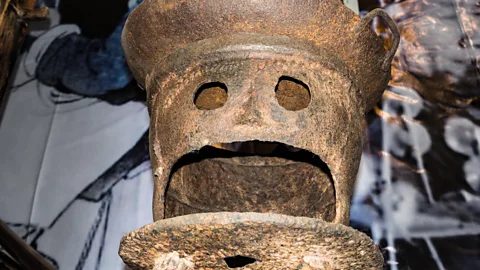Why we personify threatening events
 Getty Images
Getty ImagesAs hurricanes Lee and Margot sweep across the US, David Robson looks at why we name the things that threaten us – and whether this is helpful.
How do you picture a menace that creeps into your home unannounced and takes your loved ones?
In plague-infested Europe, the answer was the skeletal, hooded figure that we have come to know as the Grim Reaper. He first emerged in the 14th Century, during the time of the Black Death, as wave after wave of the infection (caused by the bacterium Yersinia pestis) swept across the continent and killed half its population.
The exact form of this macabre being may vary from country to country – "Death" may be young or old, male or female, dressed in white or black – but most folklores across history represent illness and death in a human form.
Following the scientific Enlightenment, you might think we would avoid personifying natural phenomena and imbuing them with conscious intent. Yet a quick look at the imagery people used to describe Covid-19 suggests otherwise, with many commentators describing the virus if it had the conscious intention to destroy humanity. Cartoons depicted the virus with arms, legs and an evil grin, while US President Donald Trump spoke of it as "tough and smart". Some scientists have even started giving the different variants nicknames inspired by mythology.
Our responses to extreme weather reveal the same tendency. We give hurricanes and storms the same names we might give our children, and describe their actions in the humanising language of wrath and vengeance. We can even see it in our angry reactions to IT issues – every time we curse our computers or cajole our smartphones, we are demonstrating the automatic urge to anthropomorphise inanimate objects.
According to recent scientific research, our penchant for personification is a natural human reaction to unpredictable event, and while it is often harmless, it can sometimes lead us to underplay the real risks of the situation. It all depends on the specific characters that we create and the features we give them.
Loved-up triangles
The foundations of this scientific theory can be traced to the Scottish philosopher David Hume. "There is a universal tendency among mankind to consider all beings like themselves, and to transfer to every object, those qualities, with which they are familiarly acquaintance, and of which they are intimately conscious," he wrote in The Natural History of Religion, published in 1757. "We find human faces in the moon, armies in the clouds; and by a natural propensity, if not corrected by experience and reflection, ascribe malice and good will to everything that hurts or pleases us."
 Getty Images
Getty ImagesHume proposed that this was a way for us to cope with the uncertainty of the world – the "perpetual suspense between life and death, health and sickness, plenty and want, which are distributed amongst the human species by secret and unknown causes". Imagining a human-like mind behind events may be irrational, but it forestalls the panic that would be provoked by recognising our sheer inability to understand what has happened and to predict the likeliness of a future event.
Hurricane names
US officials first began naming tropical storms during World War Two, and in 1953 the process was formalised – though initially, they were all named after women. Today the names are chosen by the World Meteorological Organization, which has a strict six-year rotation of male and female titles. In 2028, the US will brace itself for Atlantic tropical cyclones Gaston, Tobias, Paula and Bonnie, and Eastern North Pacific cyclones Zeke, Howard, Celia and Roslyn, among others. In the Central North Pacific, the names in use are more diverse – with Hawaiian names such as Malia and Ekeka.
Until the 20th Century, Hume's assertions were purely theoretical. In the 1940s, however, an iconic experiment confirmed his suspicions and revealed that it takes surprisingly little to trick the mind into seeing human-like intention. Fritz Heider and Marianne Simmel from Smith College, Massachusetts showed their participants an animated film of geometric shapes – a large triangle, a small triangle, and a circle, moving around a screen. There is no scenery apart from a basic box with a flap. At one point, the small triangle and the circle enter the box and the flap closes.
There are no facial expressions, no faces, and no signs of body language in these purely abstract figures – yet most of the participants offered highly anthropomorphic language to describe what they had seen, and they often provided personality profiles of the different shapes. They saw it as a love story, for instance, in which the two triangles are both vying for the circle – and end up fighting over her affection. The bigger triangle was considered to be a "bully" or "villain"; he (most agreed it was male) was "aggressive" and "sly"; one participant claimed that Big Triangle must have been "blinded by rage and frustration" when his love rival escapes with the circle.
The effectance motivation
Would the participants have created such rich stories, full of intention and emotion, if the shapes had been acting more predictably? According to Hume, the answer would be no; when it came to natural phenomena, he argued that we anthropomorphise to understand things that otherwise wouldn't make sense. Psychologists describe this as the "effectance motivation" of anthropomorphism – and researchers such as Adam Waytz at Northwestern University in Evanston, Illinois, have now found good evidence for the idea.
Waytz's research primarily examined our tendency to anthropomorphise technology. In the first study, they questioned people about their own computers. They had to rate how often they faced problems with the device, and how much it appeared to "behave as if it has its own beliefs and desires". The results were exactly as predicted: the less reliable the participants' devices, the more they saw it acting with a mind of its own.
The team's next experiments all revealed the same trend. They asked participants to consider different types of devices, for example, some of which behaved more erratically than others. They were told about a clock, for example, that would either run away from you, or jump on top of you, when you hit the snooze button. The random nature of its behaviour considerably increased the participants' ratings of the device's apparent "free will" or "consciousness", compared with similar devices that lacked this element of surprise.
 Alamy
AlamyAn anthropomorphic bias was even reflected in fMRI brain scans. When learning about the unpredictable devices, the participants had heightened activity in the ventromedial prefrontal cortex and the anterior cingulate cortex. These areas that were already known to be involved in "mentalising" – that is, placing ourselves in other people's shoes and trying to understand their motives. The researchers conclude that "perceiving an agent as having a mind of its own may not be mere metaphor" – our brains are trying to consider the device's behaviour as if it were literally another person.
In their final experiment, Waytz and his colleagues directly tested whether anthropomorphism successfully reduces the feelings of uncertainty – and to do so, they returned to a version of the film that Heider and Simmel had used in their classic study from the mid-1940s, with geometric shapes running around a screen.
This time, the researchers wanted to actively encourage or discourage anthropomorphism to measure its consequences, and so they set up two sets of instructions. Before watching the clip, some were told:
"When watching these shapes, we want you try to get inside of their minds and think
about them in the same way you would think about other people."
Others were instructed:
"When watching these shapes, we want you to remain detached and think only about the observable behaviours they are performing and think about them as you might think about any other unfamiliar objects."
Afterwards, the participants were asked to rate how much they understood the shapes, and how much they could predict their future behaviour. In line with the idea that anthropomorphism arises from an effectance motivation, the instructions to "get inside the shapes' minds" increased both these ratings.
Given these results, the personification of Covid-19 may have been a natural reaction to the huge uncertainty of the pandemic, Waytz suspects. "The desire for sense-making over a very unpredictable situation, led people to anthropomorphise the disease," he says.
Lady Luck and Mr Coronavirus
The sense of control can offer useful comfort. "Our work has shown that people do feel a sense of predictability and understanding over things they anthropomorphise," Waytz says, "so regardless of whether they actually understand those things it does provide a sense of psychological relief."
The long-term consequences will depend on the context, however. At its worst, anthropomorphism can exacerbate irrational behaviour. Consider our perceptions of good fortune and the ways that it can influence our financial decision making. Katina Kulow at the University of Louisville and colleagues recently asked participants to report how much they anthropomorphised luck by rating statements such as: "To what extent does luck have intentions?" Kulow found that the more they attributed human-like characteristics to matters of chance, the more likely they were to opt for riskier choices when gambling. That's worth remembering, whenever you think that "Lady Luck" might be on your side.
 Getty Images
Getty ImagesWhen it comes to our health, however, anthropomorphism may protect us from risk. Personifying an illness seems to make the danger feel closer and increases people's sense of vulnerability, and this encourages us to take suitable precautions, according to research by Lili Wang at Zhejiang University in Hangzhou, China, and colleagues.
In the early stages of the Covid-19 pandemic, for example, they gave participants one of two messages offering information about ways to avoid infection. The only difference between the messages was the level of anthropomorphism – whether the text referred to "the coronavirus" or "Mr Coronavirus", for example.
"You can meet Mr Coronavirus through contact with an infected person when they cough or sneeze. You can also run into him when you touch a surface or object that has the virus on it, then touch your eyes, nose, or mouth," they were told. "There's currently no vaccine to keep Mr Coronavirus at bay, but you can protect yourself and others by keeping your hands clean, not touching your face, avoiding close contact with people outside of your household, and taking other common-sense measures to limit your exposure (eg staying home)."
"The idea is to make the disease seem as if it is up to something and in motion," Wang and her colleagues explained to BBC Future in an email. Despite constituting relatively small differences in language, the personification of the virus increased people's intentions to comply with the recommendations.
To replicate the result, the team conducted similar experiments for a variety of other diseases – and found very similar results each time. Whether the participants were examining information about vaccination for yellow fever, screening for breast cancer, sunscreen to avoid skin cancer, or means to reduce high blood pressure, messages that anthropomorphised the relevant illness encouraged greater compliance with the medical advice.
Given these results, Wang suggests anthropomorphism could be a helpful tactic in public health campaigns. While visual cues could also be helpful, Wang says that it may be tricky to strike the right tone. "An important concern though is that the visual cues could seem too cartoonlike or cutesy for a serious disease," he adds.
Small gods
Looking back over human history, some researchers have argued that our anthropomorphic bias might have given birth to religious deities. Those stories could have started out as vague suspicions of human-like intentions behind an unexpected event, and then over time evolved into complex belief systems. In many cases, these involve detailed descriptions of the particular figures and their power, along with traditions that were designed to appease them.
Hume proposed as much in The Natural History of Religion, and modern scientists tend to agree. "Everyday abilities to recognize and infer the mental states of other humans and to represent goals and intentions also allows people to represent, reason about, and in turn believe in, a variety of supernatural agents," writes Will Gervais at the University of Kentucky in a scientific paper on the subject. "The ability to represent gods emerges as a cognitive by-product of the human capability to perceive minds," he continues.
The available evidence supports the idea. Feelings of uncertainty are likely to increase beliefs in religious or paranormal figures, for example, and brain scans show that these beliefs often share the same neural underpinnings as other forms of anthropomorphism.
Whether we are shouting at our laptops, avoiding Mr Coronavirus or Tropical Storm Margot – the latest hurricane to form in the Atlantic – or thanking Lady Luck, it seems that humans cannot help but populate the world with imaginary beings created in our own image.
David Robson is a science writer and author of The Expectation Effect: How Your Mindset Can Transform Your Life, published by Canongate (UK) and Henry Holt (USA). He is @d_a_robson on Twitter.
--
